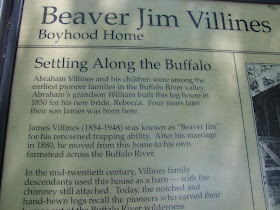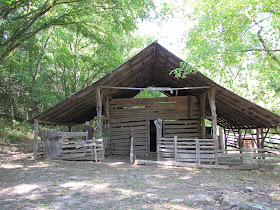It's been unbelievably hot and dry this summer in Arkansas, just replace Arkansas with your state, I know we aren't the only ones. Too hot to get out and do much but a trip over to the Ponca area in Madison County was just what I needed. As hot and dry as it's been, the Boxley Valley was surprisingly green. Canoe trips are at a standstill until we get some rain, but there are plenty of activities. All along the mountains are beautiful cabins to rent for a vacation you'll never forget. The Canopy Line Tours have zip lines that let you get up close and personal with tree tops and just up Highway 43, there are herds of Rocky Mountain Elk that live along the Buffalo River in protected wildlife areas. You can read more about them HERE.
Just past the Ponca low water bridge is the cabin that trapper "Beaver Jim" Villines built for his bride in 1850. The simple one room cabin stands as a testament to the pioneers who braved the wilderness to farm the rich bottomland along the White River.
Travel was next to impossible over winding dirt roads and the unpredictable high waters of the river, so there were few travelers through these hills. The settlers of the Ozarks made their own way, survival or die. For that reason Ozark people are a tough bunch, passing down from one generation to the next possessions and traditions.
Abraham Villines and his children were among the first pioneer families in the Buffalo River valley. Abraham's grandson William built this log house in 1850 for his new bride, Rebecca. Four years later their son James was born here.
James Villines (1854-1948) was known as "Beaver Jim" for his renowned trapping ability. After his marriage in 1880, he moved from this home to his own farmstead across the Buffalo River.
In the mid-twentieth century, Villines family descendants used this house as a barn - with the chimney still attached. Today, the notched and hand-hewn logs recall the pioneers who carved their homes out of the Buffalo River wilderness.
James Villines (1854-1948) was known as "Beaver Jim" for his renowned trapping ability. After his marriage in 1880, he moved from this home to his own farmstead across the Buffalo River.
In the mid-twentieth century, Villines family descendants used this house as a barn - with the chimney still attached. Today, the notched and hand-hewn logs recall the pioneers who carved their homes out of the Buffalo River wilderness.
The chicken house and hog pen still stand at the back of the old homeplace.
The rough mountains are still here, all around the cabin.
132 years old and the stonework on the chimney is still mostly there, amazing!
You can see the workmanship it took to build this cabin has stood the test of time.
If you're planning a trip to Arkansas, think about adding this area. If you Google, you'll see some really breathtaking pictures... mine simply cannot do credit to the beauty of the Buffalo River!



















It just amazes me what our forefathers had to do to get started in this great country of ours, We all have ties to adventurous, high spirited and hard working ancestors. Perhaps that is what gives most of us 'our grit'.
ReplyDeleteSo true! This area is still remote, rough as a cob. I can't imagine what life was like for these settlers. For those who are lucky enough to be able to live there now, it's a little piece of Heaven!
DeleteWhat cool pictures! I love Arkansas. That is where my family is from. I think often of the pioneers who did this realizing the ease I have in chores that would have taken them so much time. Just drawing enough water water to drink, cook with, clean with, and bathe with makes me tired, let alone all it took to build their homes. Truly amazing.
ReplyDeleteEverything from growing your food to carrying water was the "hard way" as Grandma used to say. I've heard my Dad talk about cabins like this that were in the Peel area where he grew up. Dirt floors, he said the women would keep them swept!???
DeleteTHANK YOU for posting this -- my grandmother's family was from this very area of Arkansas -- Low Gap to be exact. The Wishon family (as well as Hoodenpile's and Baughman's) were also early pioneers of the area and inter-married with Villines in many generations. I LOVE visiting this area and hope to again someday -- it is very beautiful....I'd love to see Beaver Jim's cabin :)
ReplyDeleteHappy Weekend!
Blessings!
Gail
I know exactly where Low Gap is and it's beautiful country too! We'll have to drive down that way this fall and get some pictures. We lived in the Harrison area years ago and knew some Baughman's, it's a small world once you start blogging!
DeleteIt's a mythical area, really, from stories and films - beautiful and unforgiving - it took a special kind of determination and grit to live there.
ReplyDeleteUnforgiving is the word, you had to be tough as nails to make it. I guess you can say that about any of our ancestors, they all sacrificed to survive!
Deletereally neat old homestead!
ReplyDeleteIt was amazing to me that it's still standing, in fact very sturdy after all these years!
DeleteLoved this post.....Love that stonework...
ReplyDeleteThe stonework was in the best condition, wondering what they used for mortar... how did they make it last so long? My Mom's house was built in 1949 and her chimney has been redone several times!
DeleteI love the Buffalo- some of the prettiest scenery up there!
ReplyDeleteIt is breathtaking! Even with the drought, it was green in the valley! They have herds of Colorado Elk there now but it was mid day and they weren't anywhere to be seen. Will have to go back over to Ponca and get some pictures of them when it cools off some!
DeleteBeautiful spot! Hope they get some good rain soon!
ReplyDeleteMe too, they need it bad. No floating on the Buffalo this summer and they depend on that. Tourism and farming are about the only moneymakers in Madison County, AR.
Delete